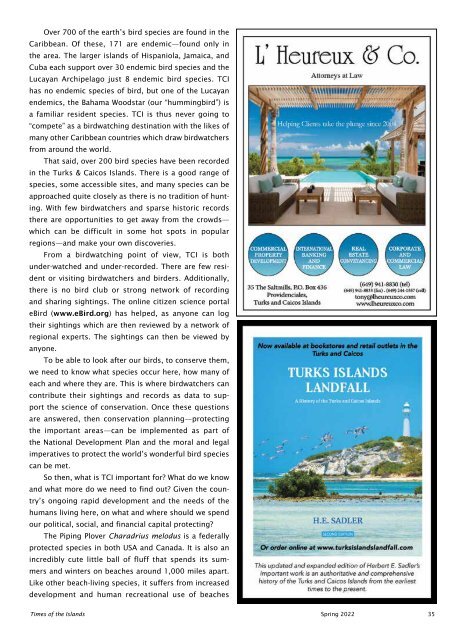Times of the Islands Spring 2022
Presents the "soul of the Turks & Caicos Islands" with in-depth features about local people, culture, history, environment, real estate, businesses, resorts, restaurants and activities.
Presents the "soul of the Turks & Caicos Islands" with in-depth features about local people, culture, history, environment, real estate, businesses, resorts, restaurants and activities.
You also want an ePaper? Increase the reach of your titles
YUMPU automatically turns print PDFs into web optimized ePapers that Google loves.
Over 700 <strong>of</strong> <strong>the</strong> earth’s bird species are found in <strong>the</strong><br />
Caribbean. Of <strong>the</strong>se, 171 are endemic—found only in<br />
<strong>the</strong> area. The larger islands <strong>of</strong> Hispaniola, Jamaica, and<br />
Cuba each support over 30 endemic bird species and <strong>the</strong><br />
Lucayan Archipelago just 8 endemic bird species. TCI<br />
has no endemic species <strong>of</strong> bird, but one <strong>of</strong> <strong>the</strong> Lucayan<br />
endemics, <strong>the</strong> Bahama Woodstar (our “hummingbird”) is<br />
a familiar resident species. TCI is thus never going to<br />
“compete” as a birdwatching destination with <strong>the</strong> likes <strong>of</strong><br />
many o<strong>the</strong>r Caribbean countries which draw birdwatchers<br />
from around <strong>the</strong> world.<br />
That said, over 200 bird species have been recorded<br />
in <strong>the</strong> Turks & Caicos <strong>Islands</strong>. There is a good range <strong>of</strong><br />
species, some accessible sites, and many species can be<br />
approached quite closely as <strong>the</strong>re is no tradition <strong>of</strong> hunting.<br />
With few birdwatchers and sparse historic records<br />
<strong>the</strong>re are opportunities to get away from <strong>the</strong> crowds—<br />
which can be difficult in some hot spots in popular<br />
regions—and make your own discoveries.<br />
From a birdwatching point <strong>of</strong> view, TCI is both<br />
under-watched and under-recorded. There are few resident<br />
or visiting birdwatchers and birders. Additionally,<br />
<strong>the</strong>re is no bird club or strong network <strong>of</strong> recording<br />
and sharing sightings. The online citizen science portal<br />
eBird (www.eBird.org) has helped, as anyone can log<br />
<strong>the</strong>ir sightings which are <strong>the</strong>n reviewed by a network <strong>of</strong><br />
regional experts. The sightings can <strong>the</strong>n be viewed by<br />
anyone.<br />
To be able to look after our birds, to conserve <strong>the</strong>m,<br />
we need to know what species occur here, how many <strong>of</strong><br />
each and where <strong>the</strong>y are. This is where birdwatchers can<br />
contribute <strong>the</strong>ir sightings and records as data to support<br />
<strong>the</strong> science <strong>of</strong> conservation. Once <strong>the</strong>se questions<br />
are answered, <strong>the</strong>n conservation planning—protecting<br />
<strong>the</strong> important areas—can be implemented as part <strong>of</strong><br />
<strong>the</strong> National Development Plan and <strong>the</strong> moral and legal<br />
imperatives to protect <strong>the</strong> world’s wonderful bird species<br />
can be met.<br />
So <strong>the</strong>n, what is TCI important for? What do we know<br />
and what more do we need to find out? Given <strong>the</strong> country’s<br />
ongoing rapid development and <strong>the</strong> needs <strong>of</strong> <strong>the</strong><br />
humans living here, on what and where should we spend<br />
our political, social, and financial capital protecting?<br />
The Piping Plover Charadrius melodus is a federally<br />
protected species in both USA and Canada. It is also an<br />
incredibly cute little ball <strong>of</strong> fluff that spends its summers<br />
and winters on beaches around 1,000 miles apart.<br />
Like o<strong>the</strong>r beach-living species, it suffers from increased<br />
development and human recreational use <strong>of</strong> beaches<br />
<strong>Times</strong> <strong>of</strong> <strong>the</strong> <strong>Islands</strong> <strong>Spring</strong> <strong>2022</strong> 35
















